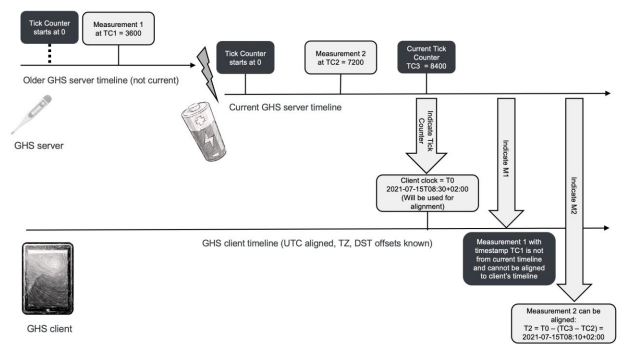The Bluetooth Special Interest Group (SIG) recently published a set of specifications that standardizes the approach in which sensor data is collected from personal health devices (PHDs) when used for remote patient monitoring (RPM). While PHDs have been used for RPM for some time, a broadly accepted standard for collecting and uploading sensor data from PHDs into the electronic record systems of healthcare providers did not exist. Lack of such a standard has led to a limited selection of PHDs a healthcare provider can supply or prescribe to patients for RPM use. This new Bluetooth® standard will lead to much greater availability of PHDs that can be used for RPM.
What Are Personal Health Devices?
Personal health devices (PHD), often referred to as consumer health devices or home health monitoring tools, encompass a range of portable electronic instruments and wearables that empower individuals to monitor and manage their own health. These devices enable users to track various health parameters, such as vital signs (e.g., blood pressure, heart rate, and blood glucose levels), activity levels, and sleep patterns, often providing real-time feedback and data storage. They play a significant role in promoting self care, chronic disease management, and overall well-being, empowering users to make informed decisions about their health.
Personal Health Devices
CPAP

Blood Pressure

Blood Glucose

Blood Oxygen

ECG

Fitness Tracker
![]()
What Is Remote Patient Monitoring?
Remote patient monitoring (RPM) is a healthcare practice that utilizes technology to collect and transmit patient health data from various medical devices and sensors, often located in a patient’s home or another remote setting, to healthcare professionals for real-time monitoring and analysis. This approach allows for continuous surveillance of a patient’s vital signs, symptoms, and chronic conditions without the need for frequent in-person visits. RPM aims to improve patient care by enabling early intervention, reducing hospital readmissions, and enhancing the management of chronic diseases, ultimately promoting more efficient and patient-centered healthcare delivery.
The PHD-RPM Challenge
Over the last few years, more and more healthcare providers have recognized the significant benefits of using PHDs for RPM. However, prior to today, a broadly accepted standard for collecting and uploading sensor data from PHDs into healthcare provider electronic health record (EHR) systems did not exist. That meant EHR system providers needed to develop custom interfaces for their personal health gateway (PHG) solutions for all the PHDs they chose to support for RPM (Figure 1). As a result, this led to a relatively limited selection of PHDs that healthcare providers could supply or prescribe to their patients for RPM use.

Addressing the PHD-RPM Challenge
To address this challenge, developers of major EHR systems, RPM services, and PHDs, including Philips and Roche, came to the Bluetooth SIG to define a standardized approach for collecting and uploading PHD sensor data into EHR systems (Figure 2). The key new Bluetooth® specification that defines this standard is the Generic Health Sensor (GHS) Profile.

Implementing this new standard enables true multi-vendor interoperability and provides significant benefits to all major stakeholders in the RPM market, including healthcare providers, EHR system providers, PHD vendors, and patients.
- Healthcare providers increase the selection of PHDs that they can prescribe or recommend for use in their practice.
- EHR system providers lower system costs by eliminating the need to create and support custom interfaces and PHGs for remote patient monitoring.
- PHD vendors decrease development complexity, increasing their ability to expand their market.
- Patients gain access to a greater selection of PHDs they can use for health monitoring and proactive healthcare tracking.
The stakeholder benefits of this new standard are significant and, when combined, enable the expansion of the remote health monitoring market.
Conclusion
The Bluetooth® specifications that define this new standard have been formally adopted by the Bluetooth SIG and are now available for use by all members. Work on this new standard was conducted within the Bluetooth SIG Medical Devices (MED) Working Group with participation from Philips, Roche, LNI Health, and others. Employees of all Bluetooth SIG member companies are encouraged to join the MED Working Group to get involved with the new multi-vendor interoperable Bluetooth® standard.
![]()
FEATURED INNOVATION
Bluetooth Networked Lighting Control
Bluetooth® Networked Lighting Control systems are deployed in offices, retail, healthcare, factories, and other commercial facilities to deliver a combination of energy savings, an enhanced occupant experience, and more efficient building operations.
先日Bluetooth SIG(Special Interest Group)は、遠隔患者モニタリング(RPM)で使用されるパーソナルヘルスデバイス(PHD)におけるセンサーデータ収集のアプローチを標準化する、仕様セットを公開しました。PHDは以前からRPMに使用されていましたが、PHDからセンサーデータの収集、および医療提供者の電子記録システムにアップロードに用いるための広く認められた規格が、これまで存在しませんでした。このような規格の欠如は、医療提供者がRPM用として患者に提供・処方できるPHDの選択肢を限定することにもつながっていました。今回の新しいBluetooth®︎規格によって、RPMに使用できるPHDの可用性が大幅に高まることが期待されます。
パーソナルヘルスデバイス(PHD)とは何か
パーソナルヘルスデバイス(PHD)は、家庭用医療機器や健康測定機器と呼ばれることも多く、個人が自身の健康をモニタリングし管理するために使用できる携帯型の各種電子・ウェアラブル機器を指します。ユーザーはこれらの機器によって、バイタルデータ(血圧、心拍数、血糖値など)、活動量、睡眠パターンといった健康に関するさまざまな数値を測ることができ、多くの場合リアルタイムでフィードバックを得たり、データを保存することができます。セルフケア、慢性疾患の管理、全体的な健康管理の推進において重要な役割を果たし、ユーザーが自分の健康について十分な情報に基づいて意思決定を行うことを可能にします。

遠隔患者モニタリング(RPM)とは何か
遠隔患者モニタリング(RPM)はテクノロジーを活用する医療行為であり、さまざまな医療機器からセンサーで患者の健康データを収集して医療従事者に送信します。機器は多くの場合、患者の自宅など医療施設から離れた場所に設置され、医療従事者はリアルタイムでモニタリングと分析を行います。これにより、患者が頻繁に医療施設に通うことなく、バイタルデータ、症状、慢性疾患の状態を継続的に観察できます。RPMは早期の介入、再入院の減少、慢性疾患の管理強化による患者ケアの向上を目指し、最終的に、より効率的で患者を中心に据えた医療の実現を図ります。
PHD-RPMの課題
ここ数年、医療提供者の間ではRPMにPHDを使用するメリットへの認識が広がりつつあります。しかしこれまで、PHDのセンサーデータの収集、および医療提供者の電子健康記録(EHR)システムへのデータアップロードについて、広く受け入れられた統一規格はありませんでした。このためEHRシステムプロバイダーは、RPMで使用するすべてのPHDのパーソナルヘルスゲートウェイ(PHG)に対応する、専用のインターフェースを開発する必要がありました(図1)。その結果、医療提供者がRPM用途で患者に提供・処方できるPHDの選択肢は、比較的限られたものとなっていたのです。

PHD-RPMの課題に対応する
この課題を解決するため、PhilipsやRocheをはじめとする大手EHRシステム、RPMサービス、PHDの開発各社がBluetooth SIGに集い、PHDのセンサーデータ収集およびEHRシステムへのアップロードに向けた標準化アプローチの策定に取り組みました(図2)。この規格を規定するBluetooth®︎ の新しい仕様が、ジェネリックヘルスセンサー(GHS)プロファイルです。

この新規格の実装により、マルチベンダー間での真の相互運用性が実現し、医療提供者、EHRシステムプロバイダー、PHDベンダー、患者を含むRPM市場のあらゆる主要な関係者に大きなメリットがもたらされます。
- 医療提供者は、医療提供に際し患者に対して処方・推奨できるPHDの選択肢が増やせます。
- EHRシステムプロバイダーは、RPMのためのカスタムインターフェースやPHGの開発およびサポートが不要になることによって、システムに要するコストを削減できます。
- PHDベンダーは、開発の複雑性を減らし、市場拡大により多くの労力を振り向けられます。
- 患者にとっては、健康モニタリングや積極的なヘルスケアデータ管理に利用できるPHDの選択肢が増えます。
この新しい規格が各関係者にもたらすメリットは大きく、メリットの組み合わせの実現によって、遠隔健康モニタリング市場の拡大が可能になります。
まとめ
この新しい規格を規定するBluetooth®︎仕様は、Bluetooth SIGでの正式な承認を経て、現在すべてのメンバーに公開されています。この新規格に関する作業はBluetooth SIGのMedical Devices(MED)ワーキンググループにおいて、Philips、Roche、LNI Healthをはじめとする各社の参画により行われました。Bluetooth SIGのすべてのメンバー企業の皆様には、MEDワーキンググループに参加し、マルチベンダー間の相互運用性を実現する新しいBluetooth®︎規格に関与されることをお勧めします。























